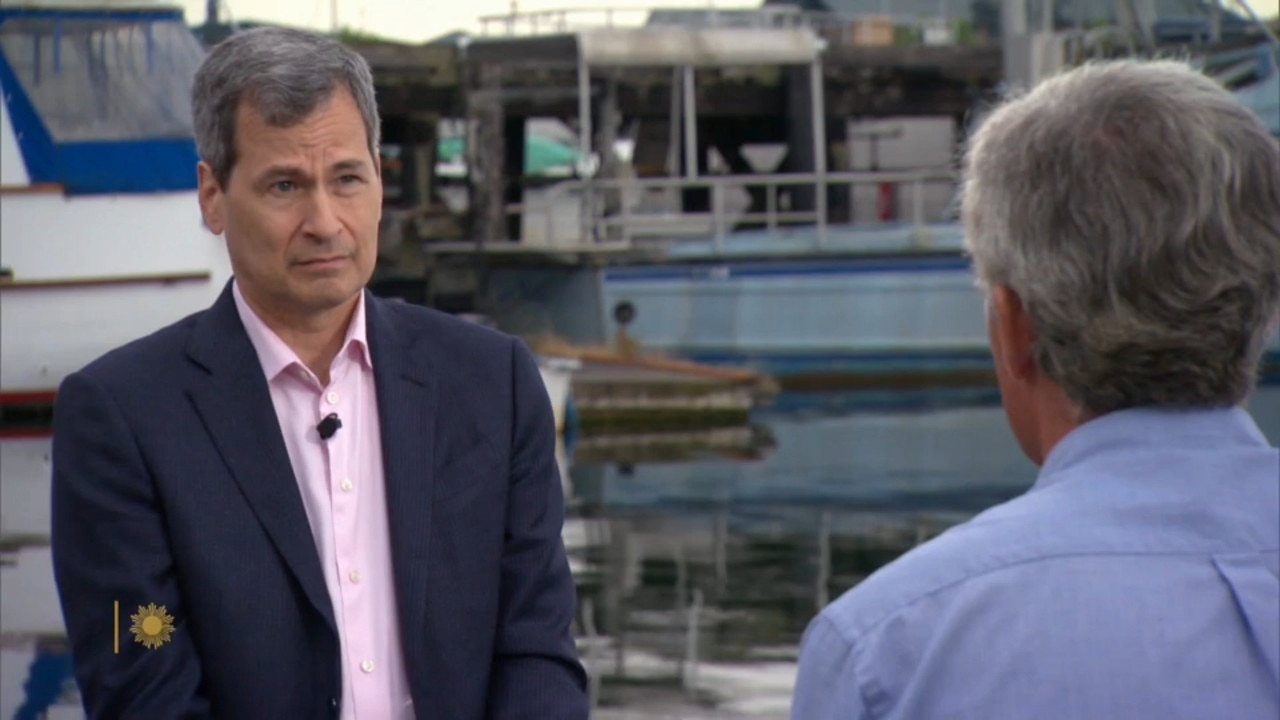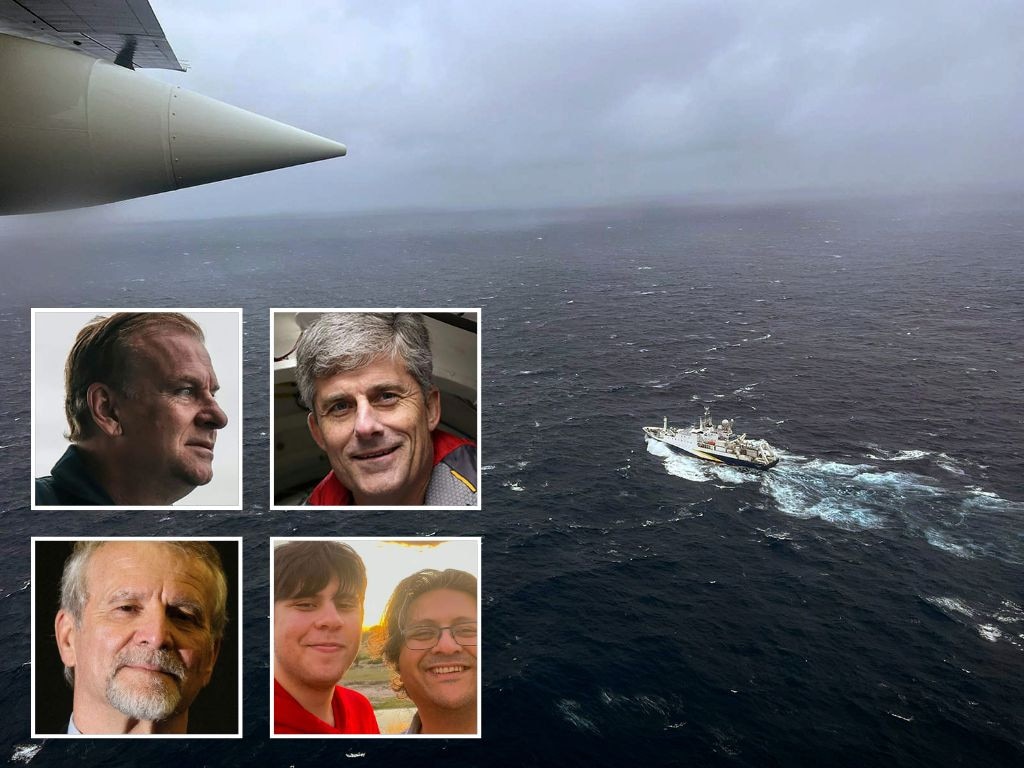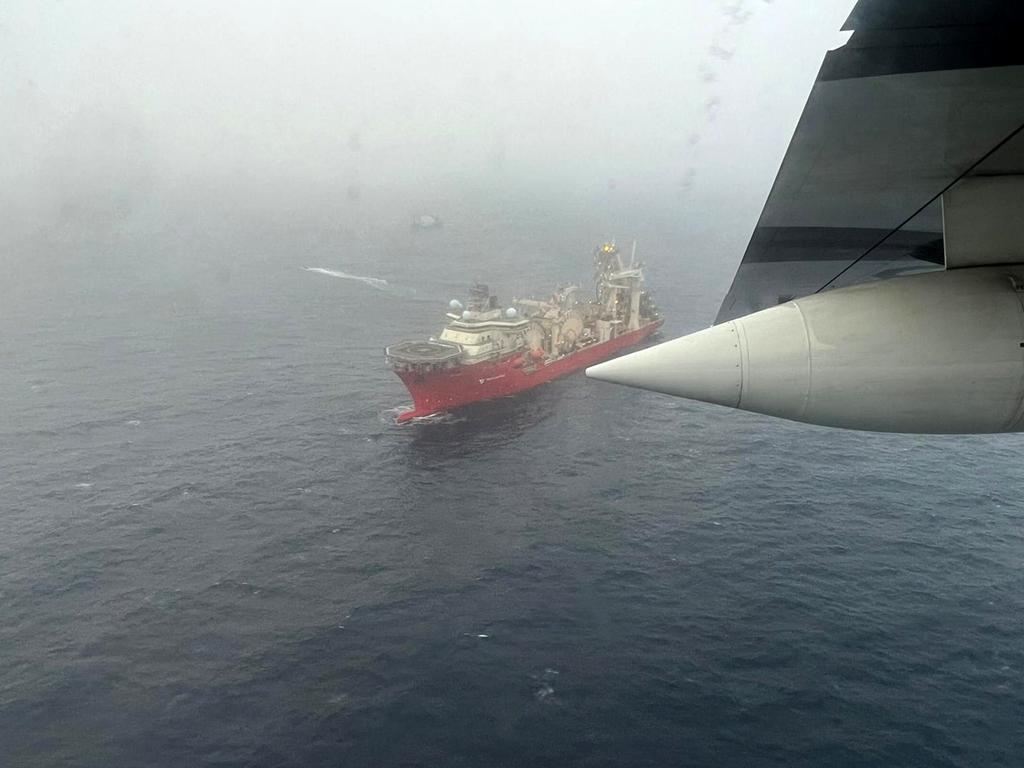Confirmation Titan sub crew has ‘sadly been lost’
The five men on-board the missing Titan sub have been confirmed dead as it’s revealed the “catastrophic” implosion may have happened days ago.
The five men on-board the missing Titanic sub have been confirmed dead.
OceanGate, the company behind the ill-fated expedition, released a statement on Friday morning confirming its CEO Stockton Rush, Shahzada Dawood and his son Suleman Dawood, Hamish Harding, and Paul-Henri Nargeolet had “sadly been lost”.
Authorities have confirmed they have found a “debris field” near the Titanic, which makes it likely the Titan submersible suffered a “catastrophic implosion”, killing all five people on-board.
Remote operating vehicles (ROVs) on the sea floor near the Titanic remain on the scene.
Key questions remain unanswered
1. What caused the implosion?
John Mauger, Rear Admiral of the US Coast Guard, confirmed the debris field found by the robot today was consistent with a “catastrophic implosion”.
An implosion is a process in which an object is destroyed by collapsing or being squeezed by force in on itself.

But it is not clear what caused the vessel - specially designed to withstand extreme depths - to implode.
David Mearns - a sub expert and friend of two of the Titan passengers - said debris found in the search for the sub could hold vital clues.
He told Sky News: “The landing frame and a rear cover from the submersible [was found].
“It means the hull hasn’t yet been found but two very important parts of the whole system have been discovered and that would not be found unless it was fragmented.”
2. What were the banging noises?
On Wednesday, it was reported that sounds were heard underwater during the search for the missing Titan sub.
At the time, it sparked new hope that the crew members could have been signalling for help.
however Rear Admiral Mauger said this morning there did not appear to be any connection between the underwater noises detected and the location of the debris on the seafloor.
3. Why was there an 8 hour delay before the alarm was raised?
OceanGate Expeditions has been criticised for an eight hour delay before it alerted the US Coast Guard that it had lost contact with the Titan.
Kathleen Cosnett, a cousin of Hamish Harding, told the Telegraph the eight-hour delay was “far too long”.
Kathleen said: “It’s very frightening. It took so long for them to get going to rescue them, it’s far too long.
“I would have thought three hours would be the bare minimum.”
OceanGate has not explained the delay.
4. Why was the sub used after safety concerns raised?
A series of crucial safety blunders were made before the sub vanished on the trip to see the Titanic wreckage on Sunday.
In a haunting interview before the vessel became lost, OceanGate CEO Stockton Rush - who was on board - claimed there should be “limits” to safety precautions.

He told CBS just last year: “You know, at some point, safety is just a pure waste.
“I mean, if you just want to be safe, don’t get out of bed, don’t get in your car, don’t do anything. At some point, you’re going to take some risk, and it really is a risk-reward question.”
Ex-employee David Lochridge claims he was fired after he raised his concerns and demanded more rigorous safety checks be put in place on the submissible.
Emergency search for doomed sub blasted: ‘Epic failure of leadership’
Republican congressman Dan Crenshaw, a former Navy SEAL, has criticised the emergency response to the missing OceanGate submersible as a “failure of leadership” after the crew was presumed dead from an implosion.
Crenshaw expressed concerns about the lack of decisive action.
“What appears to be the case is epic failure in leadership. Where exactly that leadership failure is, I don’t know. Is it the White House, Coast Guard, Navy? I’m not sure,” he told reporters from the steps of the Capitol.
Lost submarine update: I am still hearing reports that the US Government unnecessarily delayed the deployment of proper search & recovery equipment from reaching the Titanic, and now time is running out. I also hear that, contrary to USCG reports, the sub’s location is actually…
— Dan Crenshaw (@DanCrenshawTX) June 22, 2023
He suggested that deploying a 6K ROV and a Magellan submarine earlier could have made a difference.
The debris was discovered near the Titanic wreck, confirming the submersible’s implosion and the death of all five passengers.
Crenshaw highlighted the delay in deploying the necessary assets and questioned the assumption that it was an implosion without considering other possibilities.
Confirmation crew has ‘sadly been lost’
OceanGate released a statement early this morning (AEST) expressing its condolences while thanking all involved in the search efforts.
“We now believe that our CEO Stockton Rush, Shahzada Dawood and his son Suleman Dawood, Hamish Harding, and Paul-Henri Nargeolet, have sadly been lost,” it read.

“These men were true explorers who shared a distinct spirit of adventure, and a deep passion for exploring and protecting the world’s oceans. Our hearts are with these five souls and every member of their families during this tragic time. We grieve the loss of life and joy they brought to everyone they knew.”
“This is an extremely sad time for our dedicated employees who are exhausted and grieving deeply over this loss. The entire OceanGate family is deeply grateful for the countless men and women from multiple organisations of the international community who expedited wide-ranging resources and have worked so very hard on this mission.
“We appreciate their commitment to finding these five explorers, and their days and nights of tireless work in support of our crew and their families.
“We respectfully ask that the privacy of these families be respected during this most painful time.”
US Navy potentially detected submersible implosion in Atlantic Ocean
The United States Navy likely detected the probable implosion of the ill-fated Titan submersible, it has been revealed.
The vessel vanished in the depths of the Atlantic Ocean while on a mission to explore the wreckage of the Titanic.
The Wall Street Journal, citing an unnamed senior US Navy official, revealed that the implosion was detected through specialised underwater sound monitoring devices.
According to the Journal’s report, the ominous implosion occurred shortly after the Titan disappeared on Sunday, as revealed by a clandestine acoustic monitoring system specifically designed to detect submarines.
The senior Navy official said, “The US Navy conducted an analysis of acoustic data and detected an anomaly consistent with an implosion or explosion in the general vicinity of where the Titan submersible was operating when communications were lost.”

Tragically, on Thursday, the US Coast Guard announced the discovery of wreckage belonging to the ill-fated submersible near the site where the Titanic rests, a staggering 3800 meters beneath the ocean’s surface. The finding marked the conclusion of a multinational search-and-rescue operation that had persisted for four agonising days.
During a press briefing, officials sombrely informed reporters that the analysis of the debris recovered from the seafloor pointed towards the implosion of the sub’s pressure chamber.
The five lost souls
Mr Harding, a British businessman, aviator and space tourist known for his incredible adventures, sent his friend a chilling last text message a day before the expedition.
“Hey, we’re headed out tomorrow, it looks good, the weather’s been bad so they’ve been waiting for this,” he wrote.
Mr Dawood is one of Pakistan’s richest men. He has strong links to the UK, having studied law and the University of Buckingham and owning a mansion in Surrey where Shahzada lives with Suleman, his wife Christine, and daughter Alina.
“We are very grateful for the concern being shown by our colleagues and friends and would like to request everyone to pray for their safety,” the family said in a statement.

Mr Nargeolet is a veteran submarine pilot and longtime researcher of the wreck of the Titanic.
He had previously spoken about the extreme dangers of deep sea travel.
“If you are 11m or 11km down, if something bad happens, the result is the same,” he said in a resurfaced interview. “When you’re in very deep water, you’re dead before you realise that something is happening, so it’s just not a problem.”
OceanGate, one of the few companies in the world that runs commercial voyages to see The Titanic, was founded by Mr Rush in 2009.
The Everett, Washington-based company had made two previous trips to the 1912 wreckage of the “unsinkable” ship.
‘Bodies may not be recovered’ as suspected cause is revealed
Debris discovered on the ocean floor suggests the missing submersible near the wreck of the Titanic suffered a “catastrophic loss” of pressure, the US Coast Guard said.
Rear Admiral John Mauger of the US Coast Guard held a press conference where he confirmed an ROV from the vessel Horizon Arctic found the tail cone of the Titan sub about 500m from the bow of the Titanic wreck.
Additional debris consistent with a “catastrophic loss” of the pressure chamber has been discovered, authorities say.
“The debris is consistent with the catastrophic loss of the pressure chamber,” the Rear Admiral told reporters in Boston.

“Upon this determination, we immediately notified the families.”
He could not confirm whether the bodies of the crew would be recovered — “this is an incredibly unforgiving environment” — and said it was too early to say exactly when the implosion happened.
Sub company was ‘repeatedly warned’
Renowned filmmaker James Cameron, director of the iconic movie “Titanic,” has expressed his surreal sense of shock over the similarities between the 1912 Titanic sinking and the recent loss of the five-member crew during a visit to the wreck site.
In an interview with ABC News, Cameron shared his astonishment at the tragic event.
“I’m struck by the similarity of the Titanic disaster itself, where the captain was repeatedly warned about ice ahead of his ship and yet he steamed at full speed into an ice field on a moonless night, and many people died as a result,” Cameron stated.
“For a very similar tragedy where warnings went unheeded to take place at the same exact site with all the diving that’s going around all around the world, I think it’s just astonishing, it’s really quite surreal.”
‘Titanic’ director James Cameron on the ‘catastrophic implosion’ of Titan submersible: “I’m struck by the similarity of the Titanic disaster itself, where the captain was repeatedly warned about ice ahead of his ship and yet he steamed at full speed into an ice field." pic.twitter.com/vO8JkCXS5f
— ABC News (@ABC) June 22, 2023
Cameron, who is also a deep submergence engineer and has designed his own submersibles, revealed that concerns were raised by members of the deep diving community regarding OceanGate’s operation prior to the incident.
He mentioned that top players in the field of deep submergence engineering had written letters to the company, expressing their apprehension about the experimental nature of the submersible and the need for proper certification.
“Many people in the community were very concerned about this sub, and a number of the top players in the deep submergence engineering community even wrote letters to the company saying that what they were doing was too experimental to carry passengers and that it needed to be certified,” Cameron explained.
High-tech rescue vehicle ‘blocked by US officials’
A British-based firm claims it had been prevented from joining a critical recovery mission in the Atlantic Sea, potentially jeopardising the lives of five trapped individuals.
At the time of reporting it was understood the crew and passangers may have been surviving on oxygen reserves though that now appears unlikely.
According to The Telegraph, Magellan Limited, a team of deepwater specialists, has been grounded at an airport in the Channel Islands since Monday evening, awaiting clearance that has yet to materialise.
While Magellan had reportedly received approval from the UK Ministry of Defence to leave UK airspace, the United States government had allegedly withheld authorisation for their departure.
Sources claim that US officials favoured using their own vessel based in New York, which has a maximum diving capacity of 3000m, compared to Magellan’s vehicle, capable of reaching depths of up to 5000m.
Friend claimed there was ‘no chance’ of crew being found alive
An expert with a “direct connection” to the ships searching for the Titan claims he’s been told debris discovered at the site is from the missing sub.
David Mearns, who says he’s part of a group called The Explorers Club which has a line to the rescue effort, told Sky News “a landing frame and a rear cover from the submersible” has been located.
“Again this is an unconventional submarine, that rear cover is the pointy end of it and the landing frame is the little frame that it seems to sit on,” Mr Mearns said.
He said this confirms that it is the submersible.

“It means the hull hasn’t yet been found but two very important parts of the whole system have been discovered and that would not be found unless its fragmented,” he added.
Mearns, who specialises in deep water search and recovery operations, said the development indicated a “catastrophic failure,” probably “an implosion”.
“They don’t use phrases like ‘debris field’ unless there’s no chance of a recovery of the men alive. A debris field implies a breakup of the submersible,” he said.
“The only saving grace about that is that it would have been immediate, literally in milliseconds, and the men would have had no idea what was happening.”

Enormous search hardware
French ship L’Atalante deployed its underwater robot Victor 6000 at around 9.30pm Thursday (AEST) which has arms that can cut cables or perform other manoeuvres to release a stuck vessel.
Crane ship Horizon Atlantic also deployed a remotely operated vehicle (ROV) at about 9pm (AEST) which is combing the sea bed.

The Coast Guard said this ROV has found a “debris field” near the wreckage of the Titanic.
The ROVs are being joined by a US Navy CURV21 which can salvage wreckage and craft up to 6100m down — and last year pulled off a world record recovery of a Seahawk helicopter at a depth of 5814m off Japan.
“If anything can bring them up, it’s this kit,” former UK Royal Navy Rear Admiral Chris Parry said on Wednesday.
Two of the men’s wives were on ships at the surface monitoring the operation.
What we know about how Titan went missing
The submersible launched from the Canadian research vessel Polar Prince at 8am local time on Sunday and was expected to resurface at 3pm that afternoon. But communication was lost with the Titan just one hour 45 minutes into its descent.
At 5.40pm on Sunday, the US Coast Guard received a report of the “overdue” vessel, sparking a frantic and complex rescue mission.
Company officials had been criticised for waiting eight hours after they lost communication with the Titan to alert authorities.
One of OceanGate’s previous Titanic expeditions had also gotten lost for several hours, because there is no GPS underwater, according to CBS News correspondent David Pogue, who was along for the harrowing ride.
The sub’s disappearance and desperate search sparked international headlines and multiple theories as to its fate, as well as scrutiny on the safety record of OceanGate and past statements of Mr Rush.
Experts had previously suggested the submersible may have suffered a “catastrophic failure”, immediately crushing all five men under the pressure of the water above.
“The worst case scenario is that it has suffered a catastrophic failure to its pressure housing,” wrote University of Sydney professor of marine robotics Stefan Williams.
“Although the Titan’s composite hull is built to withstand intense deep-sea pressures, any defect in its shape or build could compromise its integrity — in which case there’s a risk of implosion.”

John Mixson, a retired US Coast Guard lieutenant commander who was involved in long-range search and rescue missions, also feared the worst.
“It’s hard to say whenever you just lose total communications in a situation like that what actually happened until you find the vessel,” he told Fox News. “This isn’t a common occurrence at all. Obviously, something very rapid and very tragic took place. I would say it is extremely serious. It’s a dire situation.”
Assuming the sub was still intact, other scenarios facing rescuers were that it was floating somewhere on the surface, somewhere underwater, or stuck in the 111-year-old wreckage of The Titanic.
“In a best-case scenario, the Titan may have lost power and will have an in-built safety system that will help it return to the surface,” Prof Williams wrote.
“Alternatively, the vessel may have lost power and ended up at the bottom of the ocean. This would be a more problematic outcome.”
— with The Sun and NY Post, frank.chung@news.com.au





